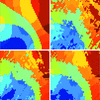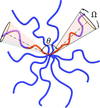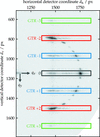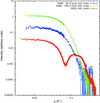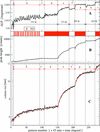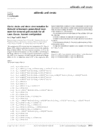issue contents
December 2014 issue

Cover illustration: Atomic force microscopy images of Bi2Te3-![[delta]](/logos/entities/delta_rmgif.gif) layers grown on BaF2(111) with different excess Te flux rates. Courtesy of Steiner et al. [J. Appl. Cryst. (2014), 47, 1889-1900].
layers grown on BaF2(111) with different excess Te flux rates. Courtesy of Steiner et al. [J. Appl. Cryst. (2014), 47, 1889-1900].
scientific commentaries
Free 

Some recent developments in neutron spin echo spectroscopy are discussed.
research papers
On the basis of a systematic analysis of the small-angle X-ray scattering of carbon fiber and its graphitic forms, an intensity component indicating a relatively large scatterer was found and ascribed to the amorphous structure. Results indicated that the amorphous regions decreased in dimension and finally transformed completely into voids as the heat treatment temperature rose to 2773 K.
An innovative combination of the Rietveld method and Bayes probability statistics is presented. The efficiency of the new approach is illustrated by high-temperature diffraction studies of certain phase transformation reactions in steel samples.
This work introduces a six-dimensional framework for the reconstruction of local orientation from near-field diffraction experiments. The underdetermined inverse problem is regularized by using modern l1 minimization techniques.
The morphology and growth mechanism of gallium telluride (GaTe) crystals were investigated. The exploration of the vapour-deposited GaTe platelets paves the way for the growth of crystals with superior physical properties, which would facilitate the scaling up of room-temperature radiation detector devices.
A neutron spin echo spectrometer based on neutron magnetic Wollaston prisms is introduced to measure the linewidth of dispersive phonon excitations over the entire Brillouin zone with µeV resolution. By tuning the instrument electromagnetically, the linewidths of phonon excitations with high energy and large group velocity can be measured.
A new straightforward means of quantifying the non-uniformity in X-ray scattering rings is described. The resulting metrics can be used to assess the number of crystalline grains within the scattering volume and can thus be used to estimate grain size or crystallinity.
This article reports the integral transform that determines the particle size distribution from the small-angle scattering intensity under the assumption that the particle correlation function is a polynomial.
In this paper, full-field lens-based microdiffraction imaging using X-rays is introduced as a fast technique for determining lattice strain and orientation on crystalline surfaces. With a total exposure time of less than a minute, lattice tilts down to 10−4° could be distinguished locally on a focused-ion-beam-milled silicon wafer over a surface area of 100 × 100 µm.
Epitaxial layers of topological insulators of Bi2Te3−δ grown by molecular-beam epitaxy are investigated by high-resolution X-ray diffraction.
A new model for the form factor of star polymers with excluded volume effect is presented.
X-ray diffraction and analysis of computer-simulated models are combined to study the dependence of presumed icosahedral order in a Cu–Zr–Al glass on the cooling rate at which the glasses are prepared. Significant correlations between the fraction of icosahedral clusters and the applied cooling rate are reflected by changes of the total structure factor for both the simulated and the experimentally prepared systems.
The nominal pitch of 25 nm of a self-assembled block copolymer line grating was determined as 24.83 (9) nm by the first traceable grazing-incidence small-angle X-ray scattering (GISAXS) measurements. Traceability is established by tracing all input parameters; the main contributions are the measurements of the sample–detector distance and of the pixel size.
The growth of Fe on a mesoporous structure of titania anatase template has been investigated. The lateral and longitudinal correlation of the Fe layers as a function of thickness demonstrate the impact of the deposition kinetics on the physical properties of supported islands in the nanometric regime. Three different stages of growth were identified, characterized by different correlation lengths and magnetic behaviors in each regime.
A methodology to use a laboratory X-ray diffractometer equipped with an in-plane arm to determine residual stress gradients is presented. The approach is based on an in-plane arm rotation and a characterization of several reflections to achieve a variation of X-ray penetration depth even without sample inclination.
Download citation


Download citation


The crystal structures of the post-perovskite analogues NaCoF3 and NaNiF3 have been determined from time-of-flight neutron powder data collected with the Polaris diffractometer at the ISIS spallation neutron source from samples of mass ∼56 and ∼16 Mg, respectively. The results for NaNiF3 are in good agreement with those from a single-crystal X-ray experiment using synchrotron radiation.
CCDC reference: 1027425
The crystalline structure and the melting/crystallization behavior of several synthesized diblock copolymers based on poly(∊-caprolactone) (PCL) and poly(L-lactic acid) (PLLA) have been studied by differential calorimetry and X-ray diffraction analysis (small-angle X-ray scattering and wide-angle X-ray diffraction). The influence of the presence and of the molecular weight of each block on the crystallinity behavior and the crystal nature of the other block is discussed.
The evolution of large-angle and small-angle grain boundaries in multi-crystalline silicon is studied on the basis of electron backscatter diffraction and synchrotron X-ray diffraction and comparison of light microscopy and etch pit patterns.
A detailed study on nucleation kinetics, including metastable zone width and induction period, of semi-organic L-leucine hydrobromide led to the growth of good quality bulk size crystals. The structure and its perfection were assessed by powder X-ray diffraction, the etch pit method and high-resolution X-ray diffraction. Photoluminescence, time-resolved photoluminescence and Z-scan measurements were carried out for the assessment of optical and nonlinear optical properties.
An X-ray compatible microfluidic platform for protein crystallization facilitates in situ Laue diffraction in serial crystallography.
Download citation


Download citation


A neutron diffraction study of the nuclear and magnetic structure of goethite ( -FeOOH) with varying crystallinity and temperature is presented. The antiferromagnetic structure in the Pb′nm color space group suggests spins aligned parallel to the c axis. A significant reduction in the Néel temperature was found for a nanocrystalline sample.
-FeOOH) with varying crystallinity and temperature is presented. The antiferromagnetic structure in the Pb′nm color space group suggests spins aligned parallel to the c axis. A significant reduction in the Néel temperature was found for a nanocrystalline sample.
Open  access
access
 access
accessSingle- and multi-crystal data collection strategy and automated data processing have been tightly integrated into the JBluIce graphical user interface. Grid Engine is used to distribute these processes into multiple workstations to make efficient use of all available computing resources.
Using statistical and analytical methods, experimental and simulated small-angle scattering data are analysed and characterized systematically, revealing new aspects and applications in experiment planning, experiment optimization and data analysis.
The impact of experimental uncertainties on the results of three-dimensional pair distribution function refinements is discussed for the example of the disordered crystal structure of tris-tert-butyl-1,3,5-benzene tricarboxamide. It is shown that quantitative short-range order information can be obtained with high accuracy if systematic errors are carefully accounted for.
The quasi Monte Carlo method and barycentric interpolation are used to calculate inverse pole figures from neutron diffraction data recorded under in situ mechanical testing or annealing. The described numerical procedure refers to time-of-flight engineering diffractometers and is exemplified on face-centered cubic lattice symmetry, but is not limited to this case.
The scanning X-ray nanodiffracton technique is used for mapping both the facet morphology and the crystal quality of multiple quantum wells on three-dimensional micrometre-sized epitaxial SiGe crystals grown on patterned Si substrates.
Download citation


Download citation


The swedenborgite CaBaCo2Fe2O7 shows an antiferromagnetic ordering transition with persisting hexagonal lattice symmetry, which makes it a unique model system for geometrically frustrated, layered kagome spin systems.
CCDC reference: 1031064
Download citation


Download citation


Phase identification and structure determination were demonstrated on a multiphase crystalline powder sample by the newly developed rotation electron diffraction method.
An algorithm to generate all the lattice parameters with the same computed lines is provided for application to powder indexing.
A Bayesian approach for subtraction of incoherent scattering from neutron total-scattering data has been developed and implemented in an open-source software package. The approach has been tested using both simulated and experimental data collected on different types of samples.
A powder diffraction technique allowing monitoring of the nanocrystal surface state shows a chemisorption effect on diffraction peak position that is scalable with adsorption energy and enables detection of surface reconstruction phenomena.
short communications
It is demonstrated that small-angle X-ray scattering from binary liquid mixtures close to the critical point allows straightforward in situ characterization of local X-ray beam heating of liquid samples.
computer programs
The program input4MAUD can be used for automatic input of two-dimensional diffraction image file series into MAUD, covering, for example, a single texture measurement or a batch. It also has the possibility of creating automated batch refinement jobs for MAUD.
Developing WinXPRO: a software for determination of the multipole-model-based properties of crystals
The new release of the multi-functional computer program package WinXPRO v.3x for determination of the electron-density-based crystal properties from parameters of the multipole model is described.
The computer program DPC toolkit is a simple and user-friendly tool that identifies the unit-cell lattice parameters of a crystal structure that are consistent with a given set of two-dimensional grazing-incidence wide-angle X-ray scattering data.
The SHADE web server has been updated to allow the use of ab initio calculations and experimental information. The resulting H-atom anisotropic displacement parameters are compared with neutron structures and other estimation approaches.
A computer program to assist in visualizing and characterizing solvent channels in macromolecular crystals is described.
laboratory notes
A new six-axis robotic sample changer for neutron powder diffraction experiments, including texture measurements, has enabled a novel set of experiments to be performed at the High-Pressure Preferred Orientation diffractometer at the Lujan Neutron Scattering Center.
addenda and errata
Free 

This corrigendum replaces the first corrigendum [Popa & Balzar (2012). 45, 838–839], which was published to correct errors in the article by Popa & Balzar [J. Appl. Cryst. (2001), 34, 187–195].
crystallographers
Free 



 journal menu
journal menu












